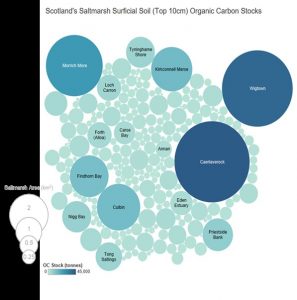Marine
New study into significance of Scottish saltmarsh
September 14, 2021 by Marine Directorate Communications No Comments | Category Blue Carbon
A new report has highlighted the significance of saltmarsh in Scotland for trapping and storing carbon, and helping to mitigate the effects of climate change.
The report was funded by the Scottish Government as part of its £650,000 commitment to the Blue Carbon Research Programme which recognises the importance of the marine environment for naturally storing carbon. This publication from the Scottish Blue Carbon Forum scientists, based at the School of Geography and Sustainable Development, University of St Andrews and the Scottish Association for Marine Science, Scottish Marine Institute, Oban, is the first national assessment of the carbon stocks found in Scotland’s saltmarsh soil.
A saltmarsh is an area of coastal grassland which is regularly flooded by seawater.
The study, which used nationwide saltmarsh vegetation mapping and extensive saltmarsh soil property data to estimate the carbon stock of surface soils within Scotland’s saltmarsh, found:
- Scottish saltmarsh soils hold about 370,000 tonnes of carbon
- The average density of carbon is about 6 kg for every square metre of saltmarsh.
- There is more carbon per square metre than in most land-based soils.
- Upper marsh, which is most inland in a saltmarsh, holds the greatest carbon density
- Scotland’s 10 largest saltmarshes hold more than 50% of the total Scottish saltmarsh soil carbon
- Scotland’s large estuarine saltmarshes hold the greatest quantity (more than 40%) of saltmarsh carbon within their soils
- The saltmarshes of Dumfries and Galloway hold the largest quantity of carbon of any of Scotland’s local authorities (41% of total Scottish surficial saltmarsh soil OC stock).
The results from these findings will help to protect and manage Scotland’s saltmarshes. It will also contribute to the Scottish Government’s work to tackle biodiversity loss, and highlight the benefits of natural habitats to climate, people and biodiversity.
This latest publication is part of a programme of work being undertaken by the Scottish Blue Carbon Forum, to grow the evidence base for blue carbon research, focusing on the carbon storage potential and the impact of human activities on blue carbon habitats in Scotland.
Further information
- Blue carbon stock in Scottish saltmarsh soils, Scottish Marine and Freshwater Science series Vol 12 No 13. Austin, W., Smeaton, C., Riegel, S., and Miller, L. 2021
- Scottish Blue Carbon Forum
- The top 10 largest saltmarshes are 1 Caerlaverock, 2 Wigtown, 3 Morrich More, 4 Kirkconnell Merse, 5 Culbin, 6 Findhorn Bay, 7 Priestside Bank, 8 Nigg Bay, 9 Tyninghame Shore and 10 Tong Saltings SSSI
Tags: #BlueCarbon, blue carbon, climate change, saltmarsh, science





Leave a comment